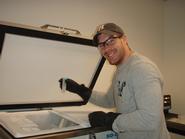
As I entered the computer lab, Trevor Pedrick '09 sat tranquilly waiting with a cup of Earl Grey tea in his hand. I learned quickly that 10:30 a.m. and 2:30 p.m. are tea time on the chemistry floor of the science building. Pedrick deserves a much needed break after working hard on encapsulating peroxidases into Sol-gel. A peroxidase is a type of enzyme. Enzymes are used to speed up chemical reactions. Trevor spends most of his day working with peroxidases as well as halophenols. Halophenols, acting as a substrate, are the chemical compound that reacts with the enzyme. In this case, the halophenol substrate loses a halogen group in the reaction.
One problem that might deter this reaction from occurring is that peroxidases are often "eaten" by proteases. The relationship predator-prey is not only found in the biology texts, but also in chemistry texts as proteases prey on the peroxidases. The protease takes away the ability of a peroxidase to synthesize the chemical process. Trevor protects the peroxidases by encapsulating them into a gel to protect them from the proteases so that the peroxidases are no longer the prey.
Trevor has been encapsulating different types of peroxidases to see which kind is best protected by the gel. The pores in the gel allow the halophenols through so that the good reaction can occur but prevent the predatory proteases from attacking the peroxidases.
The halophenol-peroxidase reaction has recently come to the attention of scientists because it is one of the chemical processes that could potentially help to detoxify industrial waste sites. However, if the proteases can get to the peroxidases, the peroxidases can not perform at the highest level and the chemical process can not continue. The breakdown of the industrial waste can only occur if the peroxidases are not losing their energy to the protease attack.
When Trevor is waiting for the gel to solidify, Trevor and his lab mates James Russell '09, Chris Lorenc '10 and Andrew Branting '11 enjoy a competitive game of solitaire. When he's not in the lab, Trevor also likes to attend power yoga class on Wednesdays, weight lift, study the culinary arts and the art of barbequing, and play guitar hero.
-- by Emma Domby '11
One problem that might deter this reaction from occurring is that peroxidases are often "eaten" by proteases. The relationship predator-prey is not only found in the biology texts, but also in chemistry texts as proteases prey on the peroxidases. The protease takes away the ability of a peroxidase to synthesize the chemical process. Trevor protects the peroxidases by encapsulating them into a gel to protect them from the proteases so that the peroxidases are no longer the prey.
Trevor has been encapsulating different types of peroxidases to see which kind is best protected by the gel. The pores in the gel allow the halophenols through so that the good reaction can occur but prevent the predatory proteases from attacking the peroxidases.
The halophenol-peroxidase reaction has recently come to the attention of scientists because it is one of the chemical processes that could potentially help to detoxify industrial waste sites. However, if the proteases can get to the peroxidases, the peroxidases can not perform at the highest level and the chemical process can not continue. The breakdown of the industrial waste can only occur if the peroxidases are not losing their energy to the protease attack.
When Trevor is waiting for the gel to solidify, Trevor and his lab mates James Russell '09, Chris Lorenc '10 and Andrew Branting '11 enjoy a competitive game of solitaire. When he's not in the lab, Trevor also likes to attend power yoga class on Wednesdays, weight lift, study the culinary arts and the art of barbequing, and play guitar hero.
-- by Emma Domby '11
Posted July 20, 2008
